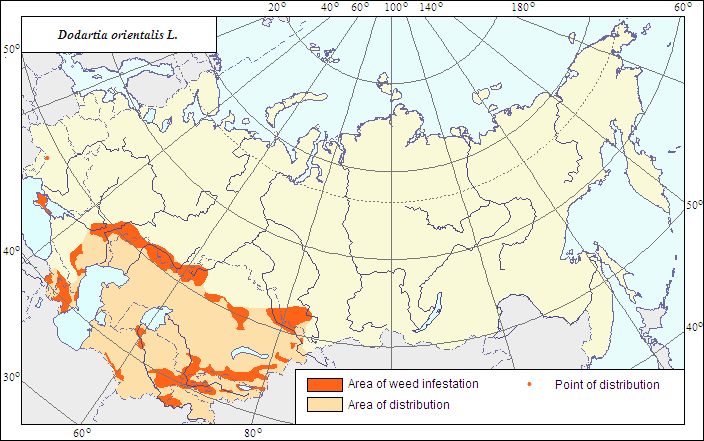Weeds
Area of distribution and weediness of Dodartia orientalis L.
 Object description Download GIS-layers
Object description Download GIS-layers
Authors:
Specialist-biologist T.D. Sokolova,GIS-specialist I.A.Budrevskaya.
Date of creation:
07.05.2007.Scale:
1:20 000 000.Accuracy of the map:
It is created on materials of maps of natural scale 1:5 000 000 - 1:100 000 000 and on literature data.Projection:
"Alber's Equal Area Conic" USSR, 9, 1001, 7, 100, 0, 44, 68, 0, 0.Basic contents:
Vector map. Area is shown by polygons (main distribution) and by dots (sporadic distribution). Zone of weediness is shown by polygons.Accuracy of the classifier:
Within the weed area, the area of main and sporadic distribution and the zone of weediness are shown where D. orientalis is a pernicious weed. The zone of weediness is established by criteria of occurrence of this species and abundance (Tanskii V.I. et al., 1998). In the limits of this zone, D. orientalis is characterized by 75% frequency of occurrence and 4 points of abundance.Method of map production:
Areas of main distribution, sporadic distribution, and weediness are established according to the analysis of the open published maps and literature. The area of D. orientalis is based on the map taken from Volkov A.N. (1935). This area is extended in the Caucasus according to data of Grossgeim A.A. (1967). Limits of the zone of weediness are established according to Ulyanova T.N. (1981), Nikitin V.V. (1979, 1983), Dadabaev A.D. (1971), specified in accordance with data on abundance and frequency of the species occurrence taken from the following references and adjusted to the limits of arable lands. According to Ulyanova T.N. (1981), D. orientalis infests wheat in the Caucasus, in Central Asia and Northern Kazakhstan. According to Nikitin V.V. (1979; 1983), D. orientalis is a widespread weed of grain crops and alfalfa in Central Asia and Southern Kazakhstan. Data of Dadabaev A.D. (1971) testify to distribution of D. orientalis in Uzbekistan in cotton crops. Sporadic distribution is shown according to Visyulina O.D. (1970).Reference citations:
Dadabaev A.D. 1971. Herbicide application in cotton-growing zone of Uzbekistan. Tashkent: FAN, 232 p. (in Russian).Grossgeim A.A. 1967. Flora of the Caucasus. V. 7. Leningrad: Nauka, 550 p. (in Russian).
Keller B.A., Lyubimenko V.N., Maltsev A.I., Fedtshenko B.A., Shishkin B.K., Rodzevich R.Yu., Kamenskii K.V., eds. 1935. Weed plants of the USSR. V. 4. Moscow & Leningrad: AN USSR, 416 p. (in Russian).
Nikitin V.V. 1979. Geographical distribution of the most important weed species of the USSR and their dynamics. Botanicheskii zhurnal 64(7): 943-949 (in Russian).
Nikitin V.V. 1983. Weed plants in the flora of the USSR. Leningrad: Nauka, 454 p. (in Russian).
Polozhii A.V. & Peshkova G.A., eds. 1996. Flora of Siberia. V.12. Novosibirsk: Nauka, 208 p. (in Russian).
Shishkin B.K. ed. 1963. Botanical atlas. Moscow-Leningrad: Izd-vo sel'skokhozyaistvennoi literatury, zhurnalov i plakatov, 504 p. (in Russian).
Shishkin B.K. & Bobrov E.G. eds. 1955. Flora of the USSR. V. 22. Moscow & Leningrad: AN SSSR, 861 p. (in Russian).
Tanskii V.I., Levitin M.M., Ishkova T.I. & Kondratenko V.I. 1998. Phytosanitary diagnostics in integrated management of cereals. In: Novozhilov K.V., ed. Compendium of methodical recommendations in plant protection. St.-Petersburg: VIZR, p. 5-55 (in Russian).
Ulyanova T.N. 1981. Weed plants in wheat of the USSR. In: Korovina O.N., ed. Catalogue of VIR world collection. Issue 320. Leningrad: VIR, 68 p. (in Russian).
Vasilchenko I.T., ed. 1953. Weed plants of Tajikistan. V. 1. Moscow-Leningrad: AN SSSR, 451 p. (in Russian).
Visyulina O.D., ed. 1970. Weeds of the Ukraine. Kiev: Naukova dumka, 508 p. (in Ukrainian).
Volkov A.N., ed. 1935. Areas of distribution of the major weed plants in the USSR. Moscow & Leningrad: State Publishing House of Kolkhoz and Sovkhoz Literature, 152 p. (in Russian).

